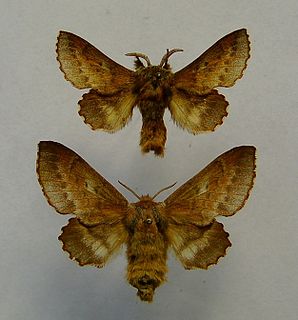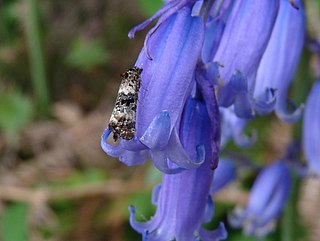
The small lappet moth is a moth in the family Lasiocampidae. The species was first described by Carl Linnaeus in his 1758 10th edition of Systema Naturae. It is found in Austria, Belarus, Belgium, China, Czech Republic, Denmark, Estonia, Finland, France, Germany, Italy, Malta, Japan, Kazakhstan, Latvia, Lithuania, Mongolia, Norway, Poland, Romania, Russia, Slovakia, Spain, Sweden, Switzerland, and Ukraine.
Haplovalva is a monotypic moth genus in the family Gelechiidae erected by Anthonie Johannes Theodorus Janse in 1958. Its only species, Haplovalva ametris, was first described by Edward Meyrick in 1921. It is found in South Africa.

Epinotia tetraquetrana, the square-barred bell, is a moth of the family Tortricidae. It is found from most of Europe east to the Near East and the eastern part of the Palearctic realm.

Ancylis mitterbacheriana is a species of moth of the family Tortricidae. It is found in most of Europe, except the Iberian Peninsula, most of the Balkan Peninsula and Ukraine.

Hysterophora maculosana, the bluebell conch, is a species of moth of the family Tortricidae. It is found from most of Europe, east to the Crimea, Asia Minor and the Palestinian territories. The habitat consists of woodland areas.
Eunebristis gyralea is a moth in the family Gelechiidae. It was described by Edward Meyrick in 1922. It is found in Amazonas, Brazil.
Helcystogramma carycastis is a moth in the family Gelechiidae. It was described by Edward Meyrick in 1922. It is found in Guyana and Amazonas, Brazil.
Ardozyga secta is a species of moth in the family Gelechiidae. It was described by Edward Meyrick in 1921. It is found in Australia, where it has been recorded from southern Queensland.
Leuronoma eodryas is a moth of the family Gelechiidae. It was described by Edward Meyrick in 1918. It is found in South Africa.
Battaristis ichnota is a moth of the family Gelechiidae. It was described by Edward Meyrick in 1914. It is found in Guyana.
Aristotelia resinosa is a moth of the family Gelechiidae. It was described by Edward Meyrick in 1918. It is found in Assam, India.
Kertomesis palacta is a moth in the family Autostichidae. It was described by Edward Meyrick in 1911. It is found in India.
Mimozela is a monotypic moth genus in the family Depressariidae. Its only species, Mimozela rhoditis, is found in Australia, where it has been recorded from Queensland. Both the genus and species were first described by Edward Meyrick in 1914.
Aeolanthes dicraea is a moth in the family Depressariidae. It was described by Edward Meyrick in 1908. It is found in India (Assam).
Aeolanthes siphonias is a moth in the family Depressariidae. It was described by Edward Meyrick in 1908. It is found in northern India.
Gonionota habristis is a moth in the family Depressariidae. It was described by Edward Meyrick in 1914. It is found in Guyana and Peru.
Odites fructuosa is a moth in the family Depressariidae. It was described by Edward Meyrick in 1915. It is found on the Comoros, where it has been recorded from Mayotte.
Anchinia furculata is a moth in the family Depressariidae. It was described by Edward Meyrick in 1925. It is found in South Africa, where it has been recorded from KwaZulu-Natal.
Anchinia oenochares is a moth in the family Depressariidae. It was described by Edward Meyrick in 1924. It is found in South Africa and Zimbabwe.
Antaeotricha celidotis is a moth in the family Depressariidae. It was described by Edward Meyrick in 1925. It is found in Peru.





